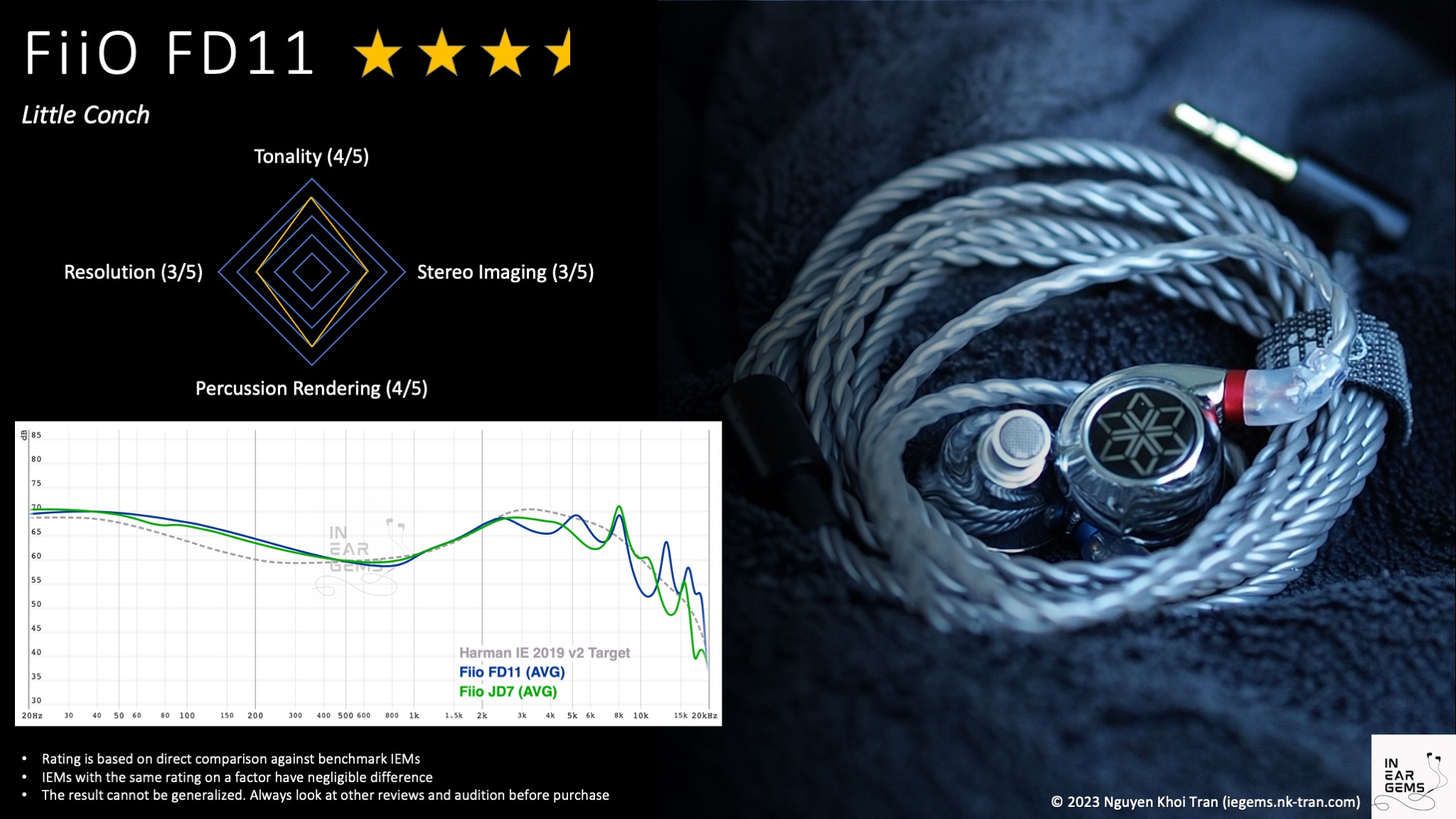FiiO FD11 - Little Conch
When I saw the announcement of FD11 on Head-Fi, I was torn. On the one hand, I am not too enthusiastic when manufacturers race to the bottom because the end products tend to sound similar and offer little more than a temporary stop on the audio journey of many listeners. On the other hand, I can’t help but being curious about what FiiO can do with FD11, since their previous release, the JD7, has been and is still my favourite single dynamic drive IEM at the budget-friendly side of the market.
Well, wonder no more. Today, we are going to talk about FiiO FD11.

Forewords
- What I look for in an IEM is immersion. I want to feel the orchestra around me, track individual instruments, and hear all of their textures and details. I’m not picky about tonality, as long as it does not get in the way of immersion.
- I rate IEMs within with a consistent scale from 1 (poor) to 3 (Adequate) to 5 (outstanding). Ratings are assigned by A/B tests against benchmark IEMs, regardless of the retail price.
- Ranking list and measurement database are on my IEM review blog.
- This review is based on a review sample from FiiO (Thank you!). I have no affiliation with or financial interest in FiiO. The unit retails for $40 at the time this review was published. Australian folks can grab a unit from Addicted to Audio. For others, please find your local distributor on FiiO’s website or grab one from Aliexpress.
Listening Setup
Source chains for listening tests:
- Reference Chain: MacBook -> FiiO K7
- Portable Setup: Shanling M6 Ultra
- Dongle: FiiO KA3
Local FLAC files ripped from CDs or bought from Qobuz were used for most casual listening and A/B tests. My playlist for A/B tests can be found on Apple Music here.
Specs
- Driver: 10mm dynamic driver
- Connector Type: 2-pin
- Impedance: 24ohm@1kHz
- Sensitivity: 111dB/mW
Build and Comfort
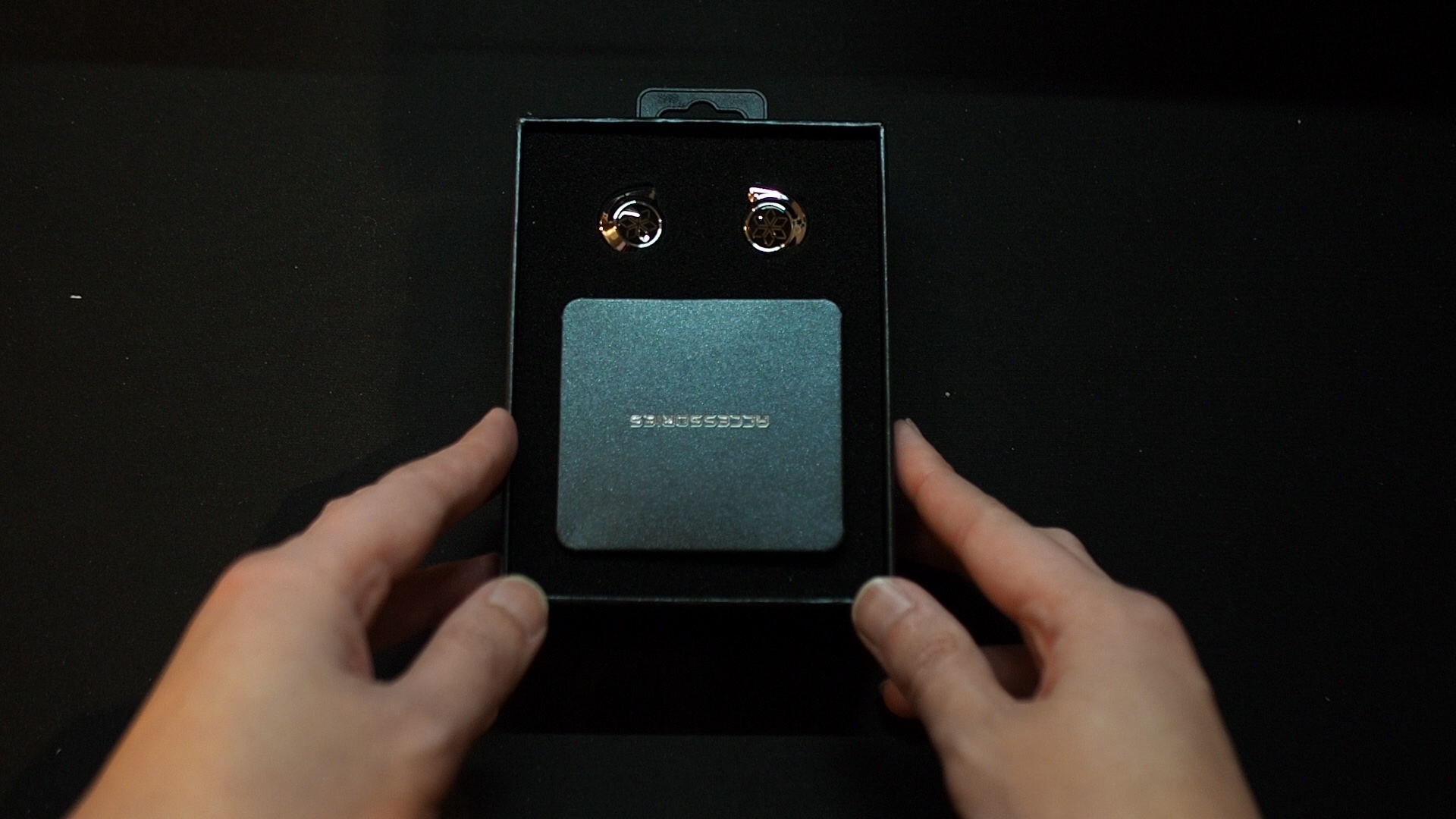
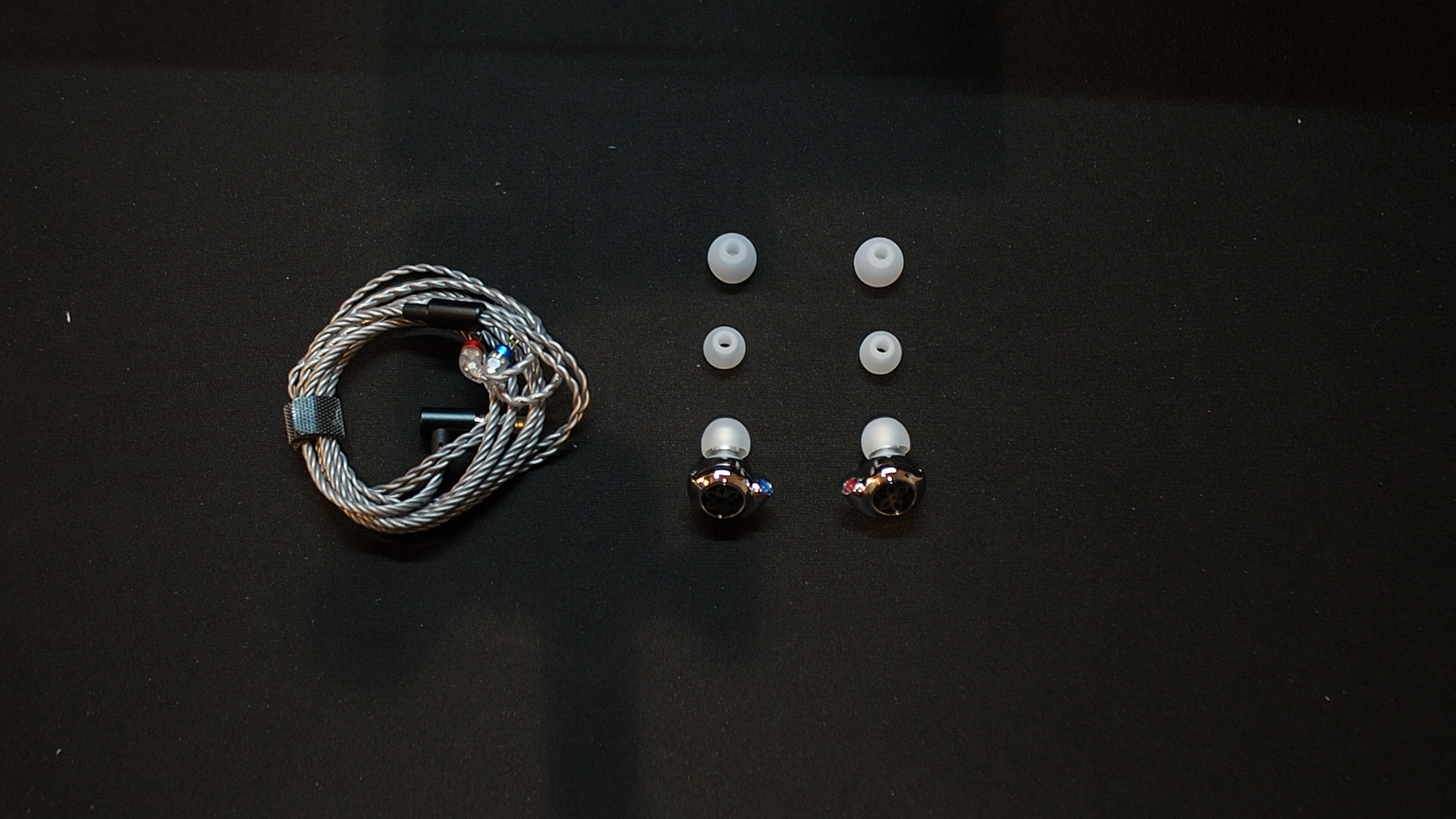
Accessories: The included accessories for the FD11 are surprisingly minimal compared to other FiiO products. Alongside the IEM, you will only find a cable and three sets of silicone tips. Notably absent are additional items like a pelican case or HS18 tips. It’s evident that FiiO has prioritized investing the budget in the IEM itself.
Stock cable: The stock cable provided with the FD11 is functional. It features a rubbery, greyish coating that lacks a premium look and feels. However, it does not produce any rubbing noises and behaves well. It’s worth noting that since the earpiece cavity is explicitly designed for the stock cable, there may be compatibility issues with other 2-pin cables. While I managed to connect the FD11 to a few cables with longer pins without any problems, the resulting appearance was not as sleek as with the stock cable. Considering the price of the FD11, the high sensitivity of these IEMs, and the likelihood that they are the first IEM for many users, I don’t believe cable compatibility will be a significant concern.
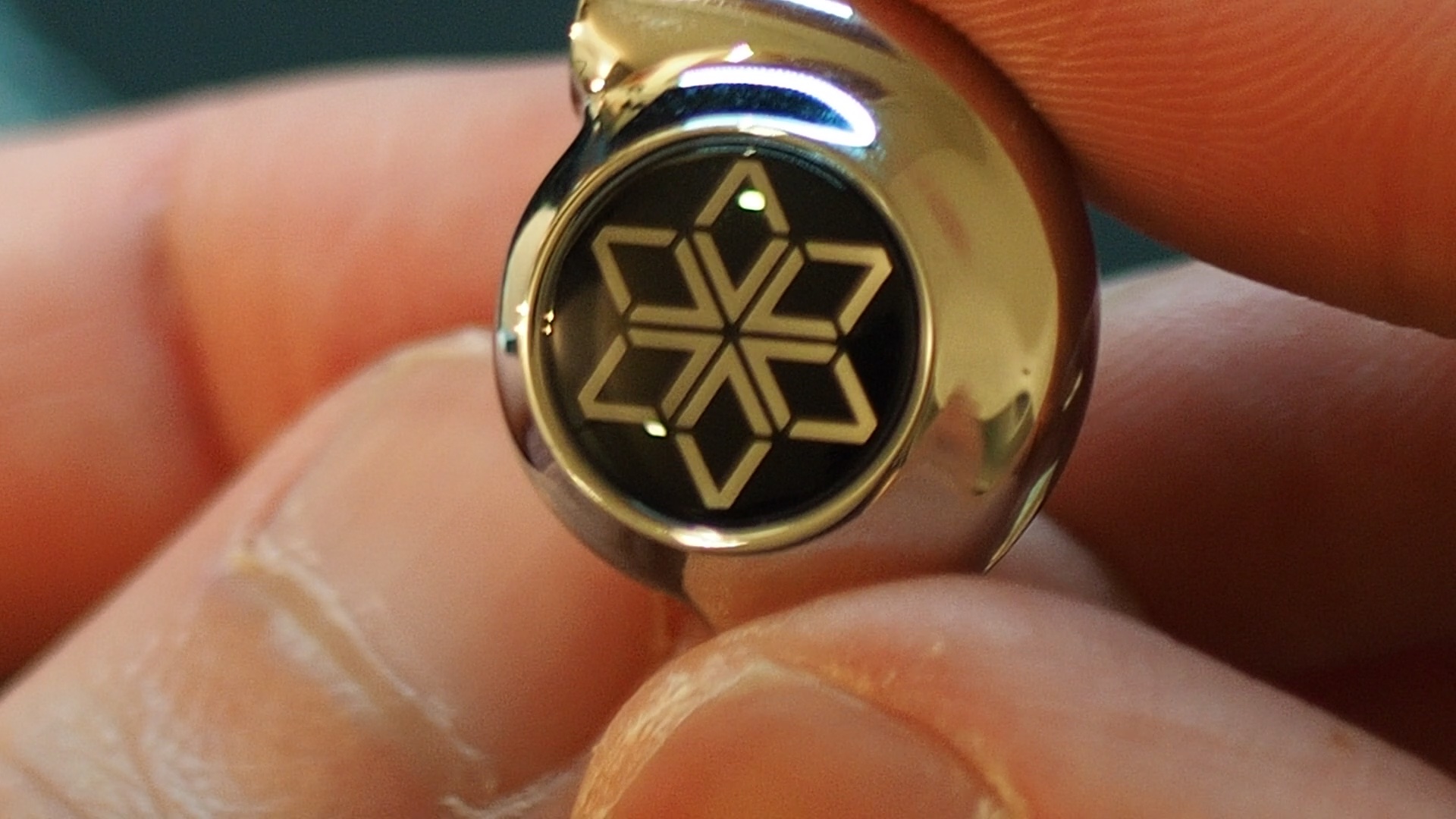
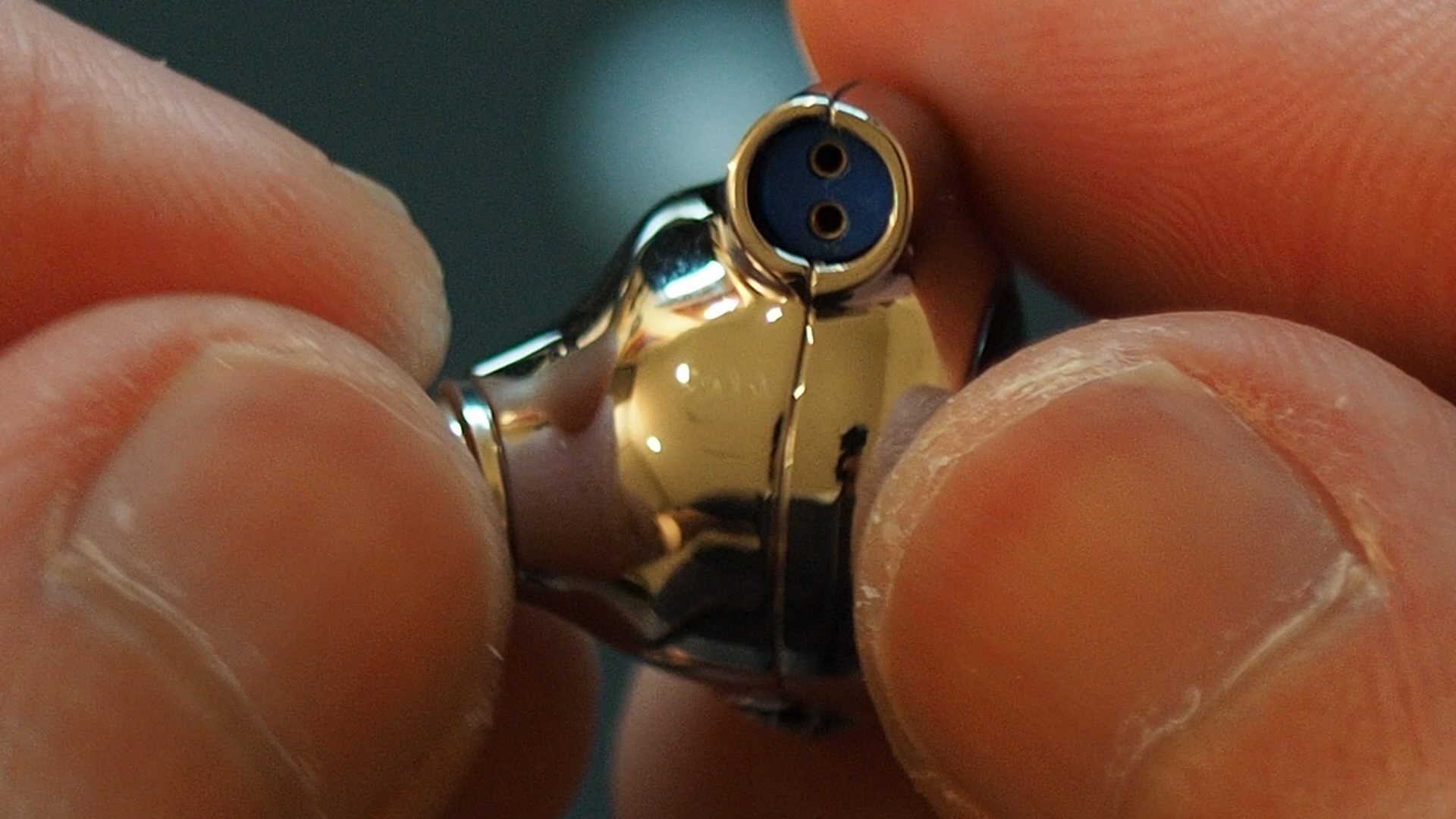


Earpieces: The earpieces of the FD11 have an appearance and feel that are more high-end than their price tag. They are constructed from a Zinc alloy, providing a substantial weight. The earpieces feature a decorative faceplate rather than vents like the FD5, FD7, and JD7. Unlike the previous generation FD1, the FD11 adopts a cylindrical shape rather than a pseudo-custom IEM design. The nozzle size and length are average, consistent with other cylindrical IEMs from FiiO.
Comfort and isolation: Now, let’s address a potential concern with the FD11: the seal. For the first time with an IEM, I encountered such difficulty achieving a good seal in my right ear. Without a proper seal, these IEMs can sound bright and harsh, lacking bass response. Eventually, I had to rely on Final Audio Type E ear tips and finesse the earpieces into place, similar to wearing an Etymotic IEM. Fortunately, I experienced good isolation and comfort once the seal was established.
Tonality
Frequency response of FD11 against the Harman in-ear target. Measurements were done with an IEC-711-compliant coupler and might only be compared with other measurements from this same coupler. Visit my graph database for more comparisons.
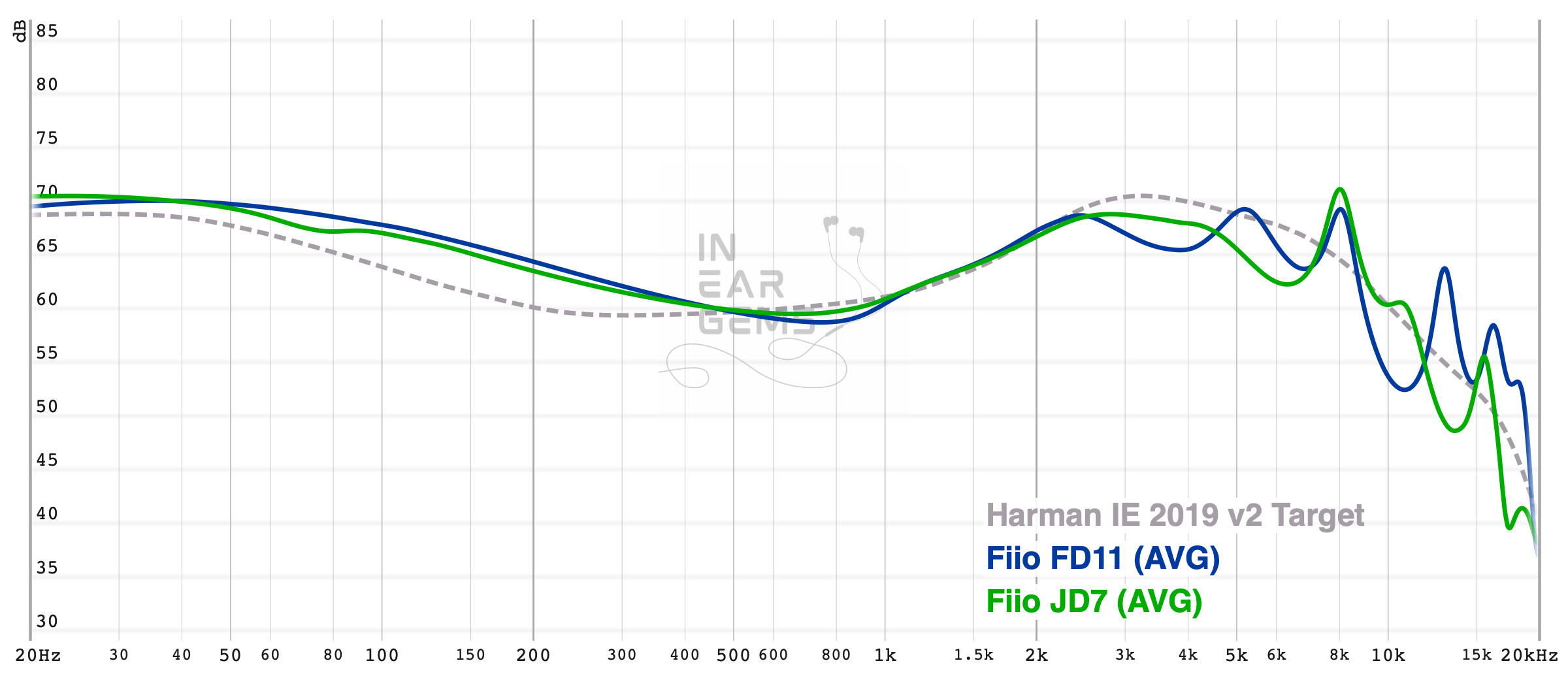
Tonality or “tuning” is where objectivity and subjectivity meet. Objectivity exists in the squiggly lines above, called Frequency Response (FR) graphs. They are created by sweeping a signal from 20Hz to 20kHz and measuring the corresponding loudness coming from an IEM. Unless a human operator deliberately tampers with the microphone or the data, FR does not care about the price or prestige of an IEM and, therefore, is “objective.”
However, human listeners are not microphones. Our ears and brain interpret the sound and decide whether it is “enjoyable.” It is also beneficial to remember that when you play a note on a musical instrument, multiple sounds (fundamental and harmonic) appear simultaneously and mix together. Achieving a life-like balance between frequencies and adding a tasteful amount of imbalance (“colouring the sound”) is the hallmark of an excellent tonality.
Sound signature:
The FD11 follows the Harman-inspired house sound common among most FiiO FD series IEMs. This sound signature can be described as “casual” or “fun.” It incorporates a bass boost, an upper-midrange boost highlighting female vocals, and a slightly subdued treble to prevent harshness. The overall tuning includes prominent peaks that add sharpness and perceived clarity to the sound.
Both mid-bass (around 150Hz, known as the “punch” region) and the sub-bass are emphasized, adding presence and punch to drums and bass guitars without overpowering the overall sound signature. The bass quality exceeds expectations for an entry-level IEM. For example, when listening to Battle Bar, I noticed clean drum attacks with a tangible physical sensation. While the bass lacks the large and rapid dynamic swings of high-end IEMs, it is more than satisfactory for an entry-level option.
The midrange of the FD11 aligns with what one would anticipate from an FD series IEM. Most instruments and vocals sound natural, realistic, and energetic, with a crisp and almost sharp character. The strong upper midrange boost, influenced by the Harman target, accentuates higher voices and brighter notes of musical instruments. Like other FD series IEMs, the FD11 exhibits “cat ears,” which are twin peaks at 2.5kHz and 5kHz. These peaks contribute to a lively, almost edgy sensation in vocals and instruments. The vibrancy and energy of this presentation would likely appeal to the intended audience of the FD11. However, I prefer the smoother yet more detailed midrange of the JD7.
The treble response of the FD11 is polite. For example, when listening to Eye of the Tiger by Survivor, I observed that cymbals and hi-hats were barely audible in the mix, overshadowed by the prominent drums and vocals. While this tuning avoids harshness and treble fatigue, I found the music somewhat lacking in the sparkle and shimmer of cymbals, hi-hats, and chimes. The quality and extension of the treble are adequate, even commendable, for an entry-level IEM. It may not provide an immersive experience regarding treble nuances, texture, and ambience. At the same time, it also doesn’t detract from the overall listening experience.
Soundstage Imaging

Stereo imaging or “soundstage” is a psychoacoustic illusion that different recording elements appear at various locations inside and around your head. Your brain creates based on the cues in the recording, which are enhanced or diminushed by your IEMs, your DAC, and your amplifier. Some IEMs present a wide but flat soundstage. Some present a “3D” soundstage with layering, depth, and height. In rare cases, with some specific songs, some IEMs can trick you into thinking that the sound comes from the environment (a.k.a., “holographic”)
The FD11 continues the legacy of the FiiO FD series in terms of delivering a spacious and open soundstage, although not to the extent of previous releases like the JD7, which featured a semi-open design for enhanced openness. The soundstage of the FD11 leans towards the larger side, allowing instruments ample space to spread out. However, the heightened sense of openness that comes with a semi-open design is absent in this model.
Soundstage imaging with music (One Winged Angel by the Danish National Symphony Orchestra): The oval-shaped soundstage feels wider than it does deep. The centre of the soundstage is positioned forward, creating a sense of sitting closer to the orchestra. This placement reduces the perception of depth. The instrument positioning is decent, with stable and usually clear boundaries between instruments unless the music becomes very busy. While the sense of layering is not particularly strong, there is still a general perception of instrument distance. However, the outermost background layer of the soundstage, like the choir, is not very pronounced and doesn’t provide a distinct sense of distance from the main mass of sound at the centre of the soundstage.
Soundstage imaging with games (CS GO Gameplay by Throneful): The soundstage shape appears predominantly flat, with the majority of sound positioning occurring from left to right. Locating the distance of sounds from the front or back becomes more challenging in this scenario.
Resolution

Resolution is a fascinating subject due to the difficulty of pinning down what it really is. To me, “resolution” can be broken down into three components:
- Sharpness, incisiveness, or “definition” of note attacks (see the figure above).
- The separation of instruments and vocals, especially when they overlap on the soundstage.
- The texture and details in the decay side of the notes.
The first two give music clarity and make it easy to track individual elements of a mix. The last provides music details and nuances. Generally, a smooth frequency response and good drivers give the best resolution.
Clarity and Separation (One Winged Angel by the Danish National Symphony Orchestra): Regarding clarity and instrument separation, the FD11 performs at an average level. Still, it stands out as excellent within its price range. The energetic tuning of the FD11 allows for a relatively clear outline of each instrument. Notably, the cellos section on the stage’s right side, close to the middle, exhibits excellent texture. However, during busier music sections, such as around 2:30 in the mentioned track, the FD11 loses some ability to cleanly separate overlapping instruments. Nevertheless, for the most part, and if one doesn’t scrutinize too closely, the FD11 delivers a clean and clear sound.
Detail retrieval (Paganini Caprice 24 by Daniel Lozakovich): I must say I was pleasantly surprised by the detail retrieval capabilities of the FD11. Within the broader context of IEMs, it performs at least at an average level. It is pretty impressive, considering its price point. I can discern some micro details, such as finger tapping on the fingerboard and the sympathetic resonance of the strings. It’s important to note that these details may require more effort to detect, and some may not be as prominent. Nevertheless, enough details are present to avoid an overly smoothed-out and textureless presentation. The FD11 also adequately reveals the reverb of the violin in the recording hall, showcasing a decent but not exaggerated extension in the treble.
Source Pairing
The FD11 is easy to drive. It can achieve plenty of volume output from any dongle, yet it does not highlight hissing noise. One of the most significant advantages is that there is minimal loss in sound quality when transitioning from a desktop setup to a low-end dongle.
Apple dongle:
Switching from the FiiO K7 to the Apple dongle, I noticed two key differences in the sound of the FD11. Firstly, the attack of bass notes becomes less incisive. There also appears to be a slight decrease in bass extension. However, these differences are relatively subtle and require careful A/B testing to discern. Secondly, the stereo image becomes flatter and less separated. The background layer of the soundstage no longer projects further into the background, away from the listener. Once again, the differences are only noticeable when conducting A/B tests with suitable tracks.
Average dongle (FiiO KA3):
When pairing the FD11 with the KA3 dongle, I observed the midrange being pushed forward more than usual. This effect is a known characteristic of the KA3. The bass regains its incisiveness and punchiness, and the sense of separation between the centre of the stage and the background is restored. The difference in sound quality between this pairing and the K7 pairing is negligible, making it a pretty sweet spot in terms of price/performance ratio.
Comparison and Rating
Tonality:
The tonality of the FD11 is vibrant without being harsh or overwhelmingly bassy. The tuning leans towards a more edgy and sharp midrange, which enhances its perceived clarity. While there are a few aspects I would personally change, such as smoothening the midrange, reducing the ear-gain, and extending the treble, I believe FiiO’s tuning is a good match for the targeted audience, which includes casual listeners and beginners. Overall, I would rate the tonality as good (4/5)
Percussion Rendering: Aria (3/5) < FD11 (4/5) = Blessing 2 (4/5) < U12T / E5000 (5/5)
The bass of the FD11 is punchy and satisfying, and surprisingly, it exhibits solid quality. I can discern a decently snappy attack and good sub-bass extension, which are notable strengths of the FD11’s performance. 4/5 - Good.
Resolution: Aria (3/5) <= FD11 (3/5) < Blessing 2 (4/5) < Andromeda 2020 (4.5/5) < U12T (5/5)
When it comes to resolution, the FD11 falls somewhere between the “adequate” level offered by a good single dynamic driver (DD) IEM like the Moondrop Aria and the “good” level provided by the Blessing 2. The vibrant tuning of the FD11 contributes to better perceived clarity compared to the Aria, although the true resolution remains within a similar range. I would rate the resolution of the FD11 as adequate (3/5)
Soundstage: Aria (3/5) = FD11 (3/5) < Blessing 2 (4/5) < Andromeda 2020 (5/5)
In terms of soundstage and imaging, the FD11 performs at a level similar to that of a good single dynamic driver IEM like the Moondrop Aria. The soundstage does not feel congested and exhibits relatively well-defined stereo imaging. However, it lacks a certain degree of precision compared to higher-tier models. I would rate the soundstage of the FD11 as adequate (3/5)
Special Comparisons
When reviewing the FD11, one of the main questions I had was how close it would come to the sound quality of another FiiO release and my personal favorite within its price range, the JD7. Upon listening, I immediately noticed two distinct approaches to the Harman-inspired tuning. The FD11 follows the typical FD tuning by adding some edginess to enhance clarity and energy. On the other hand, the JD7 offers a smoother sound, allowing micro details to shine through at the expense of some perceived clarity.
In terms of soundstage imaging, the JD7 has a clear advantage. It creates a more open and spacious soundstage, offering a wider and more three-dimensional presentation compared to the smaller and tighter soundstage of the FD11. However, the FD11 does have a slight edge when it comes to bass quality, as its bass feels slightly tighter.
So, which one should you choose? Personally, I still prefer the JD7 with an aftermarket cable because of its more elegant tuning and spacious soundstage. However, the FD11 fulfills its intended purpose admirably at a lower price point, making it a solid choice for those seeking a simple IEM.
Conclusion
The FD11 from FiiO is a solid budget release. It boasts a vibrant sound signature. The treble is well controlled, avoiding any sibilance or harshness that can be fatiguing over time. The bass is deep and snappy, delivering a satisfying punch. Additionally, the FD11 exhibits decent resolution and imaging. However, it is important to note the possibility of fit and seal issues. The fit and seal are my only concern about FD11, as beginners and casual listeners would not have a drawer of ear tips to try to mitigate the problem, should they fail to achieve a good seal. And without a good seal, FD11 sounds thin and harsh with very little bass.
In terms of target audience, I think FD11 is suitable for casual listeners who prioritize affordability and a good sound experience without getting too caught up in the concepts of “scaling” and “synergy” that often come with higher-end equipment. FD11 also serves as an excellent entry point for beginner head-fiers who are exploring the world of IEM.
Pros:
- Vibrant sound signature
- Well controlled treble that is not sibilant or harsh
- Deep and snappy bass
- Decent resolution and imaging
Cons:
- Potential fit and seal problem
